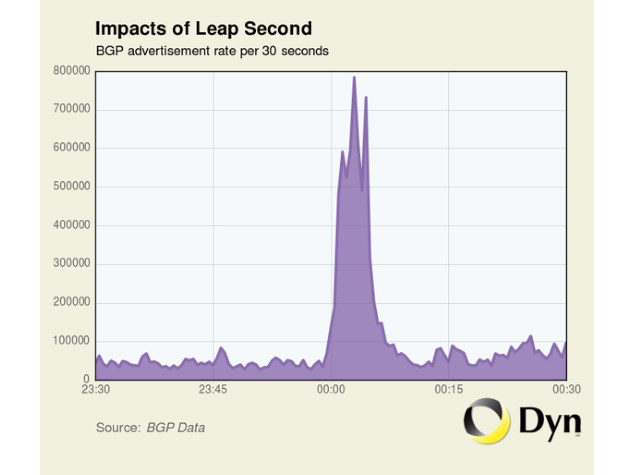2015 Leap Second Causes Minor Disruption to Internet Services
Advertisement

A leap second resulted in minor disruption to computer networks around the world on Tuesday, June 30, compared to more severe disruption in previous occurrences. Leap seconds are a rare phenomenon, but not unprecedented - there have been 26 of them since the introduction of the concept in 1972. The previous leap second, in 2012, had resulted in major disruption to multiple websites and essential services.
Wired reported a spike in traffic at midnight on June 30 caused by the failure of over 2,000 nodes and the resulting need to reroute traffic. The severe part of the spike lasted for around five minutes, according to data from Internet infrastructure firm Dyn Inc, followed by another five minutes of above-average traffic as things went back to normal.
The disruption appears to have been entirely between backend systems, with no user-facing services perceptibly affected. NBC New York reported disruption to Amazon Web Services and its customers including Netflix, Instagram and Pinterest, but a later clarification from Amazon pinned the disruption on an outside provider, not the leap second.
The 2012 leap second had caused outages to major services as it was the first in over a decade to have been added at the end of June rather than the end of December; usually a holiday. Reddit, LinkedIn, StumbleUpon, FourSquare, MeetUp, Gawker Media's websites, the Mozilla foundation all experienced disruptions and Quantas Airways had to reschedule flights. Prior to that, there had been problems with GPS systems and computer servers although patches to address the concept of leap seconds have generally resulted in fewer old devices experiencing trouble.
Several large companies such as Google and Amazon have implemented "leap smears" that distribute the duration of a leap second throughout the day to compensate for the gap at the end, allowing Unix time to remain on schedule. Some sensitive financial operations such as the New York Stock Exchange and several commodities markets decided to cease operations for at least an hour to ensure that leap potential new second disruptions are addressed safely.
Advertisement
Leap seconds are added manually to UTC time by a global body called the International Earth Rotation and Reference Systems Service (IERS) in order to compensate for variations in the Earth's rotation around the sun and maintain synchronisation with UT1 solar time, which is determined by the duration of a mean solar day. UTC is the standard by which nearly all clocks on Earth regulate time, including those that generate network pulses (Network Time Protocol or NTP servers) and those used for navigation, such as air traffic controllers. UTC has replaced GMT as the scientifically accurate standard by which all time zones are defined.
NTP now has the capability of alerting systems to an upcoming leap second anomaly up to a few months in advance. However, computers which were not designed to accommodate the irregular pattern of leap seconds can still choke when they receive conflicting scheduling instructions. The gap between 12:59:59 and 00:00:00 UTC needs to be accounted for. Unix time, a widely used standard which is a simply an ever-increasing counter of the number of seconds that have elapsed since a specific moment in 1970, effectively needs to repeat a beat every leap second.
Advertisement
Several organisations have called for an abolition of the very idea of leap seconds, allowing UTC and UT1 time to drift apart. Others advocate for a larger correction once every hundred or so years that can be scheduled and prepared for long in advance, rather than dozens of tiny disruptive ones with little notice.
For the latest tech news and reviews, follow Gadgets 360 on X, Facebook, WhatsApp, Threads and Google News. For the latest videos on gadgets and tech, subscribe to our YouTube channel. If you want to know everything about top influencers, follow our in-house Who'sThat360 on Instagram and YouTube.
Advertisement
